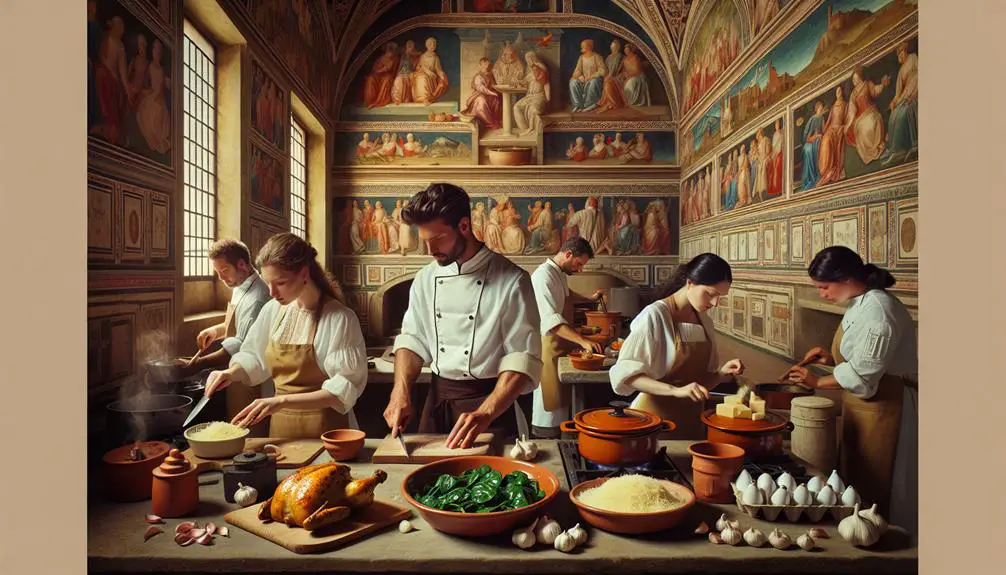Chicken Florentine is a popular dish made with chicken and spinach. Its origin is not just in Tuscany, but it has a surprising history that goes beyond Italy. The dish has evolved over time, influenced by important people and changing tastes.
It is loved by many and can be found on menus all around the world. There are also different ways to make it, with variations in the recipe.
Origin of Chicken Florentine: Italian Culinary Heritage

When you look into Florence’s food history, you’ll find a mix of ingredients and cooking styles that made it famous for its food.
The city’s food has been around for a long time, starting with the Medici family and the regular people in Tuscany.
Florence is in Tuscany, where the food is full of strong flavors like olive oil, fresh herbs, and great Chianina beef that make classic Italian dishes.
They like to keep it simple and use good ingredients without making things too complicated.
One famous dish is ‘bistecca alla Fiorentina,’ which is a thick T-bone steak cooked with just a bit of local olive oil, rosemary, and salt over a wood fire. It’s not just a meal, it’s an important experience for food lovers.
Then there’s ‘pane Toscano,’ which is a simple bread without salt that goes back to a money argument in the Middle Ages.
Even though it seems plain, when you dip it in a rich tomato sauce called ‘pappa al pomodoro,’ you’ll see why it’s important.
When you learn about Florence’s food history, you find more than just recipes. You’ll hear stories about surviving, making new things, and being passionate, which all helped make Italian food popular around the world.
Birth of Chicken Florentine

While checking the history of Chicken Florentine, you won’t find any old texts saying it started in Florentine kitchens.
The dish actually changed in other places, influenced by Catherine de Medici’s French cooks.
People often say ‘Florentine’ means it has spinach, but the dish we know today, with yummy chicken and creamy sauce, is more French than Florentine.
It’s cool to find out that the name ‘Florentine’ for dishes came from Catherine de Medici when she went to France.
But some famous chefs, like Pierre Franey, aren’t sure how much Catherine really changed French cooking. But the name sticks, maybe because it sounds fancy and smart like Florence.
When you look into it more, you see that Chicken Florentine’s story is about changing and making things simpler.
It started as a fancy dish but got turned into a quick meal found at buffets and parties.
The real deal, with crispy chicken and spinach in a yummy sauce, got replaced by easy things like canned soups.
Now, people are trying to bring back the fancy side of the dish. They want to use fresh stuff instead of processed food and make the flavors brighter and better.
Chicken Florentine is becoming more special again, going from a boring casserole to a dish that really shows off its fancy name.
Cultural Influences

The Chicken Florentine recipe was shaped by the ingredients and events in Florence. Spinach, a key local ingredient, was commonly used in Florentine dishes, showing the city’s love for fresh, local produce. The use of spinach in Chicken Florentine honors this tradition.
Picture the busy markets in Florence where chefs and home cooks picked the best ingredients from the Tuscan soil to create dishes that reflected the region’s landscapes.
Historical events also influenced Florentine cooking, like the story of Catherine de Medici and Henry II of France.
Even though it’s not entirely true that she introduced spinach to the French court, stories like this have shaped the mythos of Florentine cuisine.
When you enjoy Chicken Florentine, you’re experiencing a culinary tradition that combines local flavors and history, giving you a taste of Florence’s past with ingredients that have been used for centuries.
Migration and Global Adaptations

When Italians moved to different parts of the world, they took the recipe for Chicken Florentine with them.
In America, the dish started off in fancy restaurants but ended up being served at weddings and in casseroles. This dish shows how people can change and adapt, just like the Italian diaspora did.
Some places stick to the traditional recipe, using simple and good ingredients like fresh spinach and creamy béchamel on perfectly cooked chicken.
But in other places, they mix things up by using different greens or adding new spices.
In South America, Italian cooking mixed with local flavors. They might serve Chicken Florentine with a spicy chimichurri sauce to add a herby kick to the creamy sauce.
In Asia, they put a twist on the classic recipe by using coconut milk and lemongrass in the sauce and marinating the chicken in local spices.
Even in Australia, they added their own touch by using Macadamia nuts for a crunchy layer, showing their love for local ingredients.
Every version of Chicken Florentine tells a story of how Italian cuisine traveled and changed in kitchens around the world.
It’s not just a dish, it’s a story of how food can bring people together from all over the world.
Culinary Techniques and Ingredients

Thinking about Chicken Florentine around the world, it’s clear that picking the chicken and choosing special herbs, veggies, and sauces is super important for making this awesome dish.
You should start with really good chicken, like boneless and skinless breasts. Dry them off well to get rid of extra wetness that could stop them from getting that nice golden-brown sear.
Put lots of salt and pepper on the chicken to give it good flavor. Then, make sure the chicken is all the same thickness by pounding it to about a half inch.
Next, cover the chicken in flour, shaking off any extra; this part is really important for that tasty crust.
In the pan, use both oil and butter for frying. The oil stops it from burning, while the butter makes it taste rich.
When the chicken is cooked and put aside, it’s time to focus on the veggies and sauce.
Spinach is the main veggie in Chicken Florentine, and you just need to cook it quickly until it wilts but still looks bright and has lots of good stuff in it.
For the sauce, cook shallots and garlic in the same pan to make it taste really good, and then add a bit of white wine to get all the yummy bits off the bottom.
Heavy cream, cooked until it’s the right thickness, makes the creamy part of the sauce.
Sprinkle on some Parmesan cheese for a salty, yummy taste. Add some lemon zest and juice to make it all taste fresh and balanced.
And there you go, Chicken Florentine that’s as fancy as it sounds.
Notable Recipes

Get ready to learn about Chicken Florentine recipes! They’ve different ways to make this dish, and I’m going to tell you all about it.
First, you make the classic one by cooking spinach with oil and salt, then cooking the chicken and making a yummy sauce with chicken stock, cream, shallots, and garlic.
Then you mix in Parmesan cheese, lemon zest, and juice. Put the spinach in the sauce, and pour it on top of the chicken. You can add more Parmesan on top.
For a fancy version, you can add sun-dried tomatoes and artichoke hearts to the sauce, or use coconut milk instead of cream and make it thick with arrowroot powder.
You can serve this one on cauliflower rice with basil on top.
Some cool places make Chicken Florentine into different things. Like wrapping it in pastry and baking it, or turning it into a tasty soup.
They all keep the delicious taste of the chicken, creamy sauce, and spinach, showing that old recipes can change but still be awesome.
Cultural Significance

Chicken Florentine isn’t really from Italy, even though it has ‘Florentine’ in its name. It’s actually from America, not Italy.
The name ‘Florentine’ comes from Florence, but it’s more about history than food. It’s a mix of cultures, like when Catherine de Medici and her cooks from Florence influenced French food.
They used the term ‘Florentine’ for dishes with spinach because Catherine liked it.
So, even though it sounds fancy, Chicken Florentine isn’t a common dish in Italy. It’s more likely to be found in American Italian-style restaurants, not in Italian markets.
In Italy, each region has its special dishes, and Chicken Florentine didn’t originate there. But it’s still a reminder of how Italian food has influenced dishes around the world.
So, when you make Chicken Florentine, you’re not just cooking; you’re showing how Italian food has inspired dishes everywhere.
Culinary Impact and Contemporary Trends

Chicken Florentine isn’t really a popular dish in Florence, but it’s super famous in fancy restaurants all over the world.
Chefs are making it in new and cool ways that keep the old flavors but make it more modern.
Instead of using heavy, old-fashioned ingredients, chefs are using fresh and healthy stuff like organic spinach and free-range chicken.
They’re also making the sauce lighter and more interesting. People who like to eat healthy and care about where their food comes from really like this new version.
Chicken Florentine can fit into all kinds of food trends.
Chefs can make it with fewer carbs for people who are watching what they eat, or they can take it apart and put it back together in a new way for people who like to try new things.
It’s a dish that can change with the times but still keeps its old flavors.
Wrapping Up
Chicken Florentine has been around for a long time and now it’s super popular all over the world. It started in Florence and means a lot to the people there. You can find it in fancy restaurants or make it at home.
It’s yummy and has spinach in it. You should learn about its history and make it with love. When you eat it, think about all the cool stuff that happened with this dish. Make it special and have fun!
